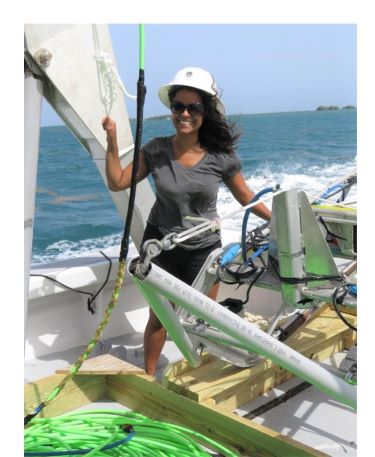
Puerto Rico native reaches the professional summit for a marine biologist
Monday, June 1, 2020
It took years of hard work and persevering through hurricanes and a pandemic for Wilmelie Cruz-Marrero, a newly minted Doctor of Philosophy in marine estuarine environmental sciences at the University of Maryland Eastern Shore, to achieve her dreams.
Cruz-Marrero, who grew up in the small town of Toa Alta, Puerto Rico as the youngest of five, knew the path she wanted to take at an early age.
“My childhood was filled with discovering our coast and native species (alongside) my parents and siblings,” Cruz-Marrero said. “My older sister, who is a wildlife biologist, let me mirror her during her field work. One day, I assisted her with an injured leatherback sea turtle. From that point on, I knew I wanted to be a marine biologist.”
She took the first step on her journey in 2006 when she started her undergraduate degree in her native Puerto Rico. There, she connected with the National Sea Grant College Program, where she helped secondary students explore and learn about the island as a marine educator. After graduating, she interned with the South Carolina Department of Natural Resources and the College of Charleston “investigating the growth rate of an invasive species of algae in comparison with native species.”
“These hands-on experiences cemented my desire to continue to learn and advance my marine science career,” Cruz-Marrero said.
The budding scientist applied to several graduate programs, but “the research suggested by Dr. Bradley Stevens at UMES caught my attention the most,” she said. “He proposed investigating potential windfarm sites off the coast of Maryland using cameras and scuba diving.”
She was hooked, and started work on her doctorate as part of UMES’ Marine-Estuarine-Environmental Science program in the fall of 2013.
“My first graduate research consisted of using a camera sled to characterize underwater habitats off the coast of Ocean City, Maryland,” Cruz-Marrero said.
Capitalizing on that experience, she secured $350,000 in funding from the National Oceanic and Atmospheric Administration’s (NOAA) Saltonstall-Kennedy Grant Program “to conduct a second and third research project in my island home of Puerto Rico.”
“Both involved using the camera sled … to count queen conch, a marine mollusk, and explore the second-most important fishery across the Caribbean,” she said.
Before the final sampling season of her research, hurricanes Irma and Maria hit Puerto Rico weeks apart in September 2017.
“My research was heavily impacted as well as my town, family and all of the inhabitants of the island,” Cruz-Marrero said. “When I was able to finally return to Puerto Rico in 2018 to complete my research, our team was able to add a new focus to our research, exploring how the hurricanes changed the marine environment. We discovered local fishermen were diving to dangerous depths to make their harvest, a practice that we hope to educate them about to make them safer.”
Cruz-Marrero successfully defended her research and findings in a dissertation, “Using Underwater Video to Assess Epibethic Community Diversity, Species Abundance, and Density Estimates,” albeit virtually in the midst of the COVID-19 pandemic.
“It was an unconventional practice for graduate defenses,” she said. “Under normal circumstances, the (doctoral) program guidelines only allow one committee member to attend remotely, rather than all. The pandemic took (away) the experience of having a traditional defense (and graduation) from me and other graduate students, but it gave us an extraordinary reach via the web.
The resulting accommodations enabled 50 people — family members, friends and colleagues — to watch from California, Florida, Maine, Maryland, Pennsylvania, Puerto Rico, Virginia and Washington, D.C.
“It was very rewarding to receive such amazing love and support,” she said.
Stevens, a professor and distinguished research scientist with UMES’ Living Marine Resources Cooperative Science Center, said, “Wilmelie’s work is significant for three reasons.”
“We have shown that capturing digital images is the best way to survey seafloor resources, whether they are queen conchs in the Caribbean or sand dollars in wind farms,” Stevens said, “because it provides a permanent record that can be analyzed by multiple reviewers, is safer than diving and can reach habitats not available to divers.”
“Second, photographs capture the relationship between organisms and their environment without disturbance,” he said. “And thirdly, the camera observes small organisms that cannot be detected by divers or other sampling gear, thus improving estimates of abundance for conch and other organisms.”
Cruz-Marrero’s academic career has led her to other far-flung destinations through NOAA internships. She helped with mapping the deepest zone of the Pacific Ocean, the Marianas Trench National Marine Monument, and assisted with scallop identification along the Atlantic coast from Delaware to Massachusetts.
Most recently, she worked as a NOAA Experiential Research & Training Opportunities intern assisting with scuba diving surveys in the U.S. Virgin Island.
Cruz-Marrero experienced many bumps along the road that have tested her endurance and commitment.
“I am a firm believer in the power of education. Knowledge gives you the wisdom to know what is right and the determination to fulfill your goals,” she said.
“The only luxury my parents could afford when I was growing up was to educate us, because, in their eyes, knowledge would give us freedom. I feel a responsibility to pass on this sentiment, sharing the knowledge and experiences I have gained in this process with future graduate students. I have found the key to success is to be persistent and never doubt your capacity to succeed regardless of the situation in front of you,” she said.
Gail Stephens, agricultural communications and media associate, School of Agricultural & Natural Sciences, 410-621-3850, gcstephens@umes.edu.

